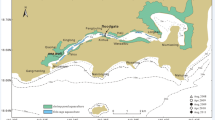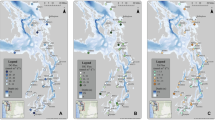Abstract
Primary production in the eutrophic Baltic Sea is limited by nitrogen availability; hence denitrification (natural transformation of nitrate to gaseous N2) in the sediments is crucial in mitigating the effects of eutrophication. This study shows that dissimilatory nitrate reduction to ammonium (DNRA) process, where nitrogen is not removed but instead recycled in the system, dominates nitrate reduction in low oxygen conditions (O2 <110 μM), which have been persistent in the central Gulf of Finland during the past decade. The nitrogen removal rates measured in this study show that nitrogen removal has decreased in the Gulf of Finland compared to rates measured in mid-1990s and the decrease is most likely caused by the increased bottom water hypoxia.



Similar content being viewed by others
References
Alenius, P., and R. Hietala. 2008. Happitilanne. In MERI – Report Series of the Finnish Institute of Marine Research No. 64, ed. M. Raateoja, Helsinki, Finland (In Finnish, English summary).
Brettar, I., and G. Rheinheimer. 1992. Influence of carbon availability on denitrification in the central Baltic Sea. Limnology and Oceanography 37: 1146–1163.
Brunet, R.C., and L.J. Garcia-Gill. 1996. Sulfide-induced dissimilatory nitrate reduction to ammonia in anaerobic freshwater sediments. FEMS Microbiology Ecology 21: 131–138.
Christensen, P.B., S. Rysgaard, N.P. Sloth, T. Dalsgaard, and S. Schwaerter. 2000. Sediment mineralization, nutrient fluxes, denitrification and dissimilatory nitrate reduction to ammonium in an estuarine fjord with sea cage trout farms. Aquatic Microbial Ecology 21: 73–84.
Conley, D.J., S. Björk, E. Bonsdorf, J. Carstensen, G. Destouni, B.G. Gustafsson, S. Hietanen, M. Kortekaas, et al. 2009a. Hypoxia-related processes in the Baltic Sea. Environmental Science and Technology 43: 3412–3420.
Conley, D.J., J. Carstensen, R. Vaquer-Sunyer, and C.M. Duarte. 2009b. Ecosystem thresholds with hypoxia. Hydrobiologia 629: 21–29.
Conley, D.J., C. Humborg, L. Rahm, O.P. Savchuk, and F. Wulff. 2002. Hypoxia in the Baltic Sea and basin-scale changes in phosphorus biogeochemistry. Environmental Science and Technology 36: 5315–5320.
Deutsch, B., S. Foster, M. Wilhelm, J.W. Dippner, and M. Voß. 2010. Denitrification in sediments as a major nitrogen sink in the Baltic Sea: an extrapolation using sediment characteristics. Biogeosciences Discussions 7: 2487–2521.
Diaz, R.J., and R. Rosenberg. 1995. Marine benthic hypoxia: a review of its ecological effects and the behavioural responses of benthic macrofauna. Oceanography and Marine Biology 33: 245–303.
Hannig, M., G. Lavik, M.M.M. Kuypers, D. Woebken, W. Martens-Habbena, and K. Jürgens. 2007. Shift from denitrification to anammox after inflow events in the central Baltic Sea. Limnology and Oceanography 52: 1336–1345.
HELCOM. 2009. Eutrophication in the Baltic Sea. An integrated thematic assessment of the effects of nutrient enrichment in the Baltic Sea region. Baltic Sea Environment Proceedings No. 115B, Helsinki, Finland.
Hietanen, S. 2007. Anaerobic ammonium oxidation (anammox) in sediments of the Gulf of Finland. Aquatic Microbial Ecology 48: 197–205.
Hietanen, S., and J. Kuparinen. 2008. Seasonal and short-term variation in denitrification and anammox at a coastal station on the Gulf of Finland, Baltic Sea. Hydrobiologia 596: 67–77.
Hietanen, S., and K. Lukkari. 2007. Effects of short-term anoxia on benthic denitrification, nutrient fluxes and phosphorus forms in coastal Baltic sediment. Aquatic Microbial Ecology 49: 293–302.
Hietanen, S., H. Jäntti, C. Buizert, K. Jürgens, M. Labrenz, M. Voss, and J. Kuparinen. 2012. Hypoxia and nitrogen processing in the Baltic Sea water column. Limnology and Oceanography. 57: 325–337.
Holmes, R.M., J.W. McClelland, D.M. Sigman, B. Fry, and B.J. Peterson. 1998. Measuring 15N-NH4 + in marine, estuarine and fresh waters: An adaptation of the ammonia diffusion method for samples with low ammonium concentrations. Marine Chemistry 60: 235–243.
Jäntti, H., C.F. Stange, E. Leskinen, and S. Hietanen. 2011. Seasonal variation in nitrification and nitrate-reduction pathways in coastal sediments in the Gulf of Finland, Baltic Sea. Aquatic Microbial Ecology 63: 171–181.
Jørgensen, K.S. 1989. Annual pattern of denitrification and nitrate ammonification in estuarine sediment. Applied and Environmental Microbiology 55: 1841–1847.
Karlson, K., S. Hulth, K. Ringdahl, and R. Rosenberg. 2005. Experimental recolonisation of Baltic Sea reduced sediments: Survival of benthic macrofauna and effects on nutrient cycling. Marine Ecology Progress Series 294: 35–49.
Kelso, B., R. Smith, R. Laughlin, and D. Lennox. 1997. Dissimilatory nitrate reduction in anaerobic sediments leading to river nitrite accumulation. Applied and Environmental Microbiology 63: 4679–4685.
Kemp, W.M., P. Sampou, J. Caffrey, M. Mayer, K. Henriksen, and W.R. Boynton. 1990. Ammonium recycling versus denitrification in Chesapeake Bay sediments. Limnology and Oceanography 35: 1545–1563.
Kivi, K., S. Kaitala, H. Kuosa, J. Kuparinen, E. Leskinen, R. Lignell, B. Marcussen, and T. Tamminen. 1993. Nutrient limitation and grazing control of the Baltic plankton community during annual succession. Limnology and Oceanography 38: 893–905.
Kristensen, E. 2000. Organic matter diagenesis at the oxic/anoxic interface in coastal marine sediments, with emphasis on the role of burrowing animals. Hydrobiologia 426: 1–24.
Kuparinen, J., and L. Tuominen. 2001. Eutrophication and self-purification: Counteractions forced by large-scale cycles and hydrodynamic processes. Ambio 30: 190–194.
Lehtoranta, J. 2003. Dynamics of sediment phosphorus in the brackish Gulf of Finland. Monographs of the Boreal Environment Research 24. PhD Thesis, Helsinki, Finland, University of Helsinki.
Mathieu, O., J. Leveque, C. Henault, P. Ambus, M. Milloux, and F. Andreux. 2007. Influence of 15N enrichment on the net isotopic fractionation factor during the reduction of nitrate to nitrous oxide in soil. Rapid Communications in Mass Spectrometry 21: 1447–1451.
Mort, H.P., C.P. Slomp, B.G. Gustafsson, and T.J. Andersen. 2010. Phosphorus recycling and burial in Baltic Sea sediments with contrasting redox conditions. Geochimica et Cosmochimica Acta 74: 1350–1362.
Nielsen, L.P. 1992. Denitrification in sediment determined from nitrogen isotope pairing. FEMS Microbiology Ecology 86: 357–362.
Risgaard-Petersen, N., L.P. Nielsen, S. Rysgaard, T. Dalsgaard, and R.L. Meyer. 2003. Application of the isotope pairing technique in sediments where anammox and denitrification coexist. Limnology and Oceanography Methods 1: 63–73.
Risgaard-Petersen, N., L.P. Nielsen, S. Rysgaard, T. Dalsgaard, and R.L. Meyer. 2004. Errata: Application of the isotope pairing technique in sediments where anammox and denitrification coexist. Limnology and Oceanography Methods 2: 315.
Savchuk, O.P. 2010. Large-scale dynamics of hypoxia in the Baltic Sea. In Chemical structure of pelagic redox interfaces: Observations and modelling, handbook of environmental chemistry, ed. E.V. Yakushev. Berlin: Springer.
Sayama, M., N. Risgaard-Petersen, L.P. Nielsen, H. Fossing, and P.B. Christensen. 2005. Impact of bacterial NO3 − transport on sediment biogeochemistry. Applied and Environmental Microbiology 71: 7575–7577.
Schulz, H.N., and B.B. Jørgensen. 2001. Big bacteria. Annual Review of Microbiology 55: 105–137.
Shaffer, G., and U. Rönner. 1984. Denitrification in the Baltic Proper deep-water. Deep Sea Research Part A. Oceanographic Research Papers 31: 197–220.
Sigman, D.M., M.A. Altabet, R. Michener, D.C. McCorcle, B. Fry, and R.M. Holmes. 1997. Natural abundance-level measurement of nitrogen isotopic composition of oceanic nitrate: An adaptation of the ammonia diffusion method. Marine Chemistry 57: 227–242.
Sloth, N.P., H. Blackburn, L.S. Hansen, N. Risgaard-Petersen, and B.A. Lomstein. 1995. Nitrogen cycling in sediments with different organic loading. Marine Ecology Progress Series 116: 163–170.
Solorzano, L. 1969. Determination of ammonia in natural water by the phenolhypochlorite method. Limnology and Oceanography 14: 799–801.
Sørensen, J., J.M. Tiedje, and R.B. Firestone. 1980. Inhibition by sulfide of nitric and nitrous oxide reduction by denitrifying Pseudomonas fluorescens. Applied and Environmental Microbiology 39: 105–108.
Tamminen, T., and T. Andersen. 2007. Seasonal phytoplankton nutrient limitation patterns as revealed by bioassays over Baltic Sea gradients of salinity and eutrophication. Marine Ecology Progress Series 340: 121–138.
Tuominen, L., A. Heinänen, J. Kuparinen, and L.P. Nielsen. 1998. Spatial and temporal variability of denitrification in the sediments of the northern Baltic Proper. Marine Ecology Progress Series 172: 13–24.
Vahtera, E., D.J. Conley, B.G. Gustafsson, H. Kuosa, H. Pitkänen, O.P. Savchuk, T. Tamminen, M. Viitasalo, et al. 2007. Internal ecosystem feedbacks enhance nitrogen-fixing cyanobacteria blooms and complicate management in the Baltic Sea. Ambio 36: 186–194.
Zillén, L., D. Conley, T. Andrén, E. Andrén, and S. Björck. 2008. Past occurrences of hypoxia in the Baltic Sea and the role of climate variability, environmental change and human impact. Earth-Science Reviews 91: 77–92.
Acknowledgments
We acknowledge the funding provided by the Onni Talas Foundation, Academy of Finland (116477), and EU-Bonus projects Assessment and Modeling of Baltic Ecosystem Response (AMBER) and Hypoxia Mitigation for Baltic Sea Ecosystem Restoration (HYPER). We are grateful for the constructive comments provided by Juha Niemistö, Heidi Holmroos, and an anonymous reviewer.
Author information
Authors and Affiliations
Corresponding author
Rights and permissions
About this article
Cite this article
Jäntti, H., Hietanen, S. The Effects of Hypoxia on Sediment Nitrogen Cycling in the Baltic Sea. AMBIO 41, 161–169 (2012). https://doi.org/10.1007/s13280-011-0233-6
Received:
Revised:
Accepted:
Published:
Issue Date:
DOI: https://doi.org/10.1007/s13280-011-0233-6




